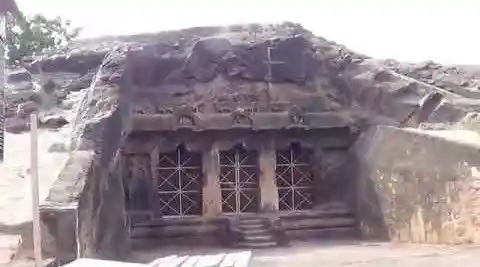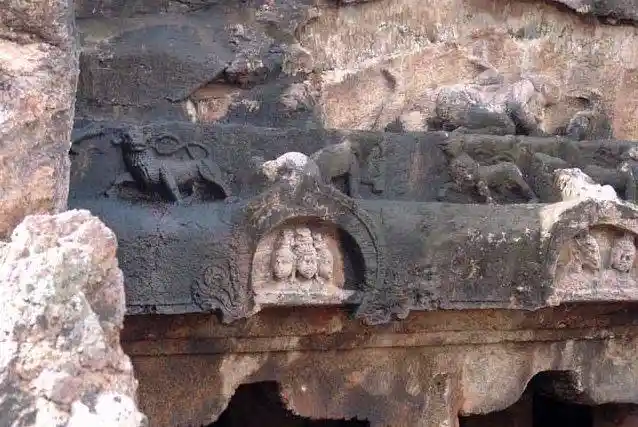Rock-Cut Marvel of Deccan Heritage
Long, long ago in the Deccan plateau, five caves were excavated amidst the hills of the ancient region of Vengi, which is now known as Andhra Pradesh. Today, these caves are recognised as the Mogalarajapuram caves, preserving countless histories and myths, and immortalising the names of their patron dynasties.

Mogalarajapuram caves illustrate the sopana, chandrasila, etc.; Source: Wikipedia
A king named Pulekeshi II from the Western Chalukyas of Badami defeated the Vishnukudins dynasty and captured the Vengi region of the current Andhra Pradesh. He appointed his brother, Kubja Vishnuvardhana, as the governor of the new territory. When Pulekeshi II passed away during the Battle of Vatapi, Vishnuvardhana declared himself the sovereign ruler of Vengi, establishing the Eastern Chalukya dynasty that endured for the next five centuries.
While some suggest that the Vishnukudins dynasty of the 6th century sponsored the excavation of these rock-cut caves due to the simplicity of the iconography of the two caves, historians and archaeologists credit the Eastern Chalukyas of Vengi, of which Vijayavatika or Vijayawada was an integral part, based on the elaborate architecture and similarities to the Badami caves.
Nestled amidst the sacred hills of Indrakil in Vijayawada is the Kanaka Durga temple, where pilgrims gather incessantly. Just 5 kilometres away, on the left bank of the River Krishna, lie the hills that cradle the rock-cut caves. The Mogalarajapuram caves comprise five cave temples and shrines dedicated to Lord Shiva, a marvellous testament to the lineage of artisans and their patrons, blending Buddhist architecture and sacred art forms.
Though the original names of the caves have been lost to the sands of time, they have adopted the name of the surrounding region, which was renamed Mogalarajapuram during the 17th or 18th century when the Mughals dissolved the Golconda Sultanate. Historians and archaeologists have conveniently numbered these caves, noting that the second and fifth caves demonstrate greater evolution in their iconography and architectural understanding. The last three caves are excavated on the same hill, while the first and second are located on the Shaivalayam hill, more than 100 meters away from the rest.
The Mogalarajapuram caves showcase the unwavering faith of their patrons through a mandapa with three sanctums dedicated to the Hindu trinity – Brahma, Shiva, and Vishnu. Although the statues are now missing, the central sanctum once housed a circular monolithic linga-pitha (platform for deities). Notably, one of the niches features a dvarapala depicting the valampuri form of Lord Ganesha – a typical Chalukyan-style rock art, with a broken tusk in one hand and a sweet modaka (sweetmeat) in the other.
The second cave exemplifies the common architecture and art forms found in all these caves, varying in sizes and poses (mudras). The caves boast a grand forecourt crafted from steeply cut rock, leading to the core through a sopana or flight of four steps, ending with a chandrasila or low screen made of stone railings. The facade is supported by two rectangular columns protruding from the walls (pilasters) and four thin pointed pillars merging into the inner surface, referred to as kapota.
The fusion of Buddhist and Chalukyan architecture can be observed through the rocky niches and structures, such as the dvarapalas flanking the front facade, jataprabha, jatamukuta, the tribhanga mudra, and the octagonal kattu. Elaborate art forms etched on the pilasters and balustrades reflect ancient art styles documented in historical texts, featuring vyalamukhas, saktidvaja, nasika kudus, and other Shaiva motifs.
The prominent iconography includes the linga patti, adorned with sculpted depictions of playing elephants, bulls, lions, semi-animals, and more. Additionally, one can find Nataraja on the sukanasi (ceiling), along with the dancing Shiva (Tandava), holding the trisula, the damru, and the parasu, with a spread hood of a naga behind the head and the tail held in the right hand. This distinctive early Chalukyan art form is typically sculpted using the shilpin tool and can also be found in sculptures from Orissa.
One of the most remarkable features among the sophisticated iconography of these caves is the friezes of Ganesha and Ardhanarisvara. The idol of Ardhanarishwari is exclusive to these caves and is not found in any other caves in India.
The saduram on the free-standing pillar in the facade depicts the carved legends of Krishna overpowering Putand and the Kuvalayapaida elephant. According to the legends, the rakshasi (demoness) Putana attempted to kill infant Krishna by breastfeeding him poisoned milk. However, Krishna ingested the poison along with the life force of the demoness.
Another depicted story involves Kansa's bull elephant, the uncle of Krishna, whose death was prophesied to be caused by his nephew. Kuvalayapaida, known for its temper and fatal violence, was expected to trample Krishna during a village ritual gathering. Yet, the Lord defeated the colossal elephant by overpowering it with his trunk and killing it with his tusk.
One can imagine the sculptures and artisans narrating these legends etched in stone, such as Kaliya-daman - the naga or King Kaliya poisoning the river Yamuna but being liberated by Krishna, authenticating the beliefs and faiths of their contemporary era and the local inhabitants. The caves serve as a mesmerising testament to the art of stone carving and offer a glimpse into the legends through the artistic lens of our ancestors.
The first cave on the Shaivalayam hill features three mandapas (sanctums): the mukha-mandapa forming the entrance, the main function hall maha-mandapa, and the devotional hall aradhna-mandapa. Each mandapa showcases malavahakas motifs of ganas and hamsa structures. The profiles etched in katti-vastra even reflect the clothing worn by these ancestors, bearing similarities with the rock art from the Pallavan and Pandya periods.
The third and fourth caves contain only one sanctum each. The former preserves remnants of the Durga Mahisasuramardini bas-relief, while the latter features a pitha for Shiva, although the deity is missing. One of the niches presents the padma-pitha displaying the four-armed Vishnu and a four-armed Brahma facing the north and south directions, respectively. The fifth cave was intended to be a three-sanctum shrine, but it remains incomplete, featuring eight pillars adorned with animal carvings.
These rock-cut gems, with their artistic brilliance, transport visitors into a world of legends, devotion, and sculpted mastery that transforms plain rocks into timeless pieces of heritage and historical archives. These rocky pages of the Mogalarajapuram caves preserve the legacy of the Chalukyas, ensuring their lives endure forever.
These sites, often merging the interests of historians and travellers, represent the marvels of our ancient monuments and architectural splendours, offering us the best treasures to behold and passing down innumerable histories for future generations. Come, indulge in the history, legends, and stories of ancient faiths, and savour the visual feast provided by the Mogalarajapuram caves of Vijayawada.

Pillars infused with inscriptions and legends; Source Amaravati Tourism

Rock art on the sadurams of pillars; Source: Amaravati Tourism


